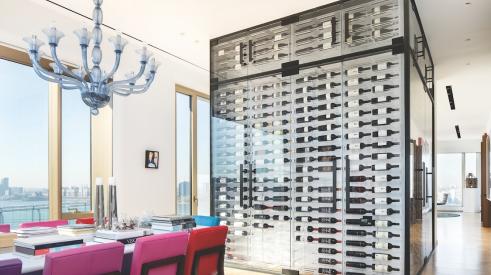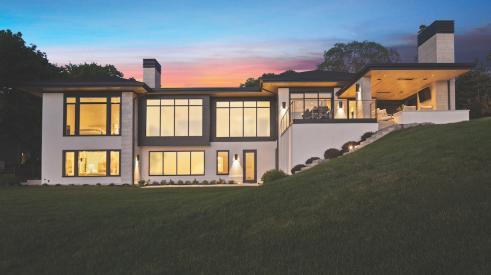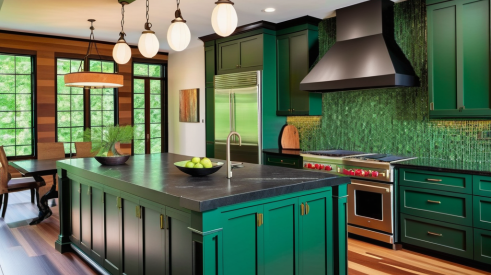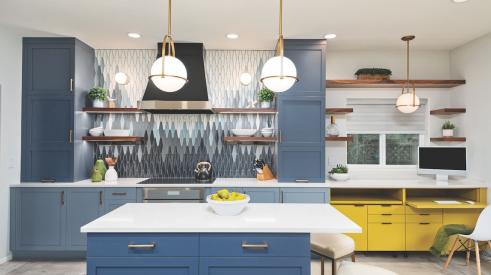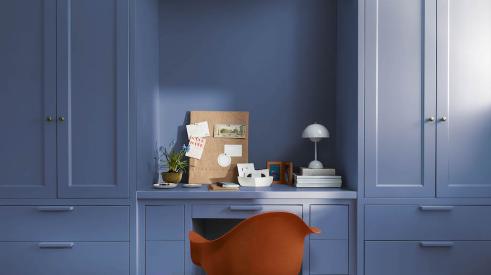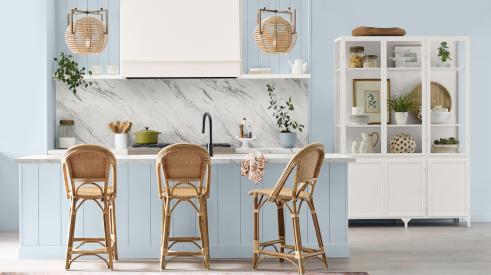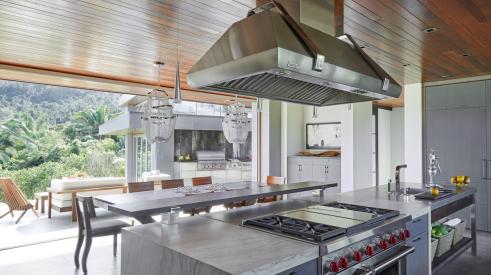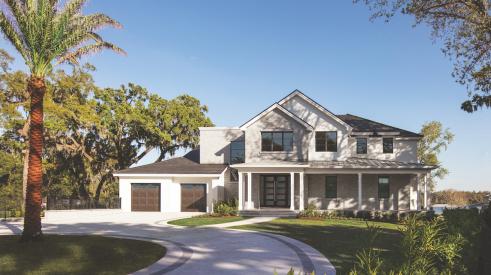| Custom cabinetry made of Honduran mahogany with an oil finish houses the 2,000-bottle collection. "It is part of making sure everything works properly together," says Lee Zinser of Cellarworks, noting that some woods put out odors, as do petroleum-based sealers. The wine cellar furniture includes custom designed racks, case and single-bottle storage, storage to display bottles, cabinets for liquor storage, shelves with inlaid glass for stemware, and drawers for corkscrews and other accessories. The copper flooring and countertops were imported from Australia. |
| Company: Cellarworks Inc., New York City Project location: New York City Age of home: 100 years Scope of project: conversion of an 8×10-foot laundry room into a wine cellar as part of a loft remodel |
A good wine collection requires more than a storage room with racks. As with the fine wines that it stores and displays, a wine cellar is a delicate balance of elements, all of which can affect the quality and preservation of the wine collection. That balance is often miscalculated, says Lee Zinser, owner of Cellarworks Inc., a New York-based company that has specialized in the design and installation of custom wine cellars for 11 years.
"About 30 percent of our calls are from people who have a failed system," Zinser says. "Our aim is to make sure that the wine cellar will not fail."
This custom wine cellar was part of the renovation of a 2,500-square-foot loft condominium in a 100-year-old former warehouse in Manhattan. The wine cellar replaced an 8×10-foot laundry room adjacent to the kitchen. A converted closet down the hall now holds a stackable washer and dryer unit.
"The new owner wanted to renovate according to his style," Zinser says. "As a collector of wine, it made sense to have a wine cellar convenient to the kitchen." Cellarworks designed and installed the wine cellar in collaboration with interior designer Todd Black, who designed the rest of the apartment.
It took a mill six weeks to build the wine cellar furniture, which Cellarworks installed, while actual renovation time in the condominium took less than four weeks. Total cost for the project was $70,000. "Everything in the system was custom," Zinser says, "from the cooling system to the furniture to the flooring from Australia and the high-end finishes."
The two most important components of the cellar are the insulation envelope and the HVAC system, he says. The room must be insulated with R-30 polyurethane closed cell insulation and a vapor barrier to produce a completely airtight unit that does not allow for moisture migration. In addition to treating organic insulation materials with a sprayed-on natural enzyme to prohibit mold from growing, says Zinser, trade contractors sealed the concrete slabs to prevent moisture from being sucked up into the space.
The custom engineered HVAC unit in this wine cellar, which is integrated within the cabinetry, was designed to "not be seen, felt or heard," Zinser says. Most cooling systems extract humidity from the air in order to cool the space. That can produce disastrous effects in a wine cellar where the humidity level must stay at 60 to 70 percent. "This system is designed not to take the humidity out of the air, but reduce the temperature to keep it maintained at 58 degrees," Zinser says. The air handler blows air through the furniture to maintain the temperature of the liquid in the bottles.
Even lighting is part of the delicate balance. UV lighting can add heat to the room. In this wine cellar, line voltage rope light in the furniture brightens the space without adding unwanted heat. The door to the room is exterior grade with double-insulated glass to keep the wine cellar separate from other living spaces.
Related Stories
Designing, Building, and Installing a Luxury Custom Wine Cube
An 11-foot wine cube enveloping a pantry is the stand out feature of this customized New York penthouse
Marvin Releases Switchable Privacy Glass Window
The privacy glass windows can be purchased from Marvin's Direct Glaze windows
Building A Small Projects Division from the Ground Up
Through hard work and careful strategy, Harth Home Services has seen big growth
Client Design Choices in the Time of Social Media and AI
Social media speeds up the trend cycles, and now artificially created images are falling into homeowners' hands
Design Trends to Watch in 2024
What’s in and out for the upcoming year? Remodeling designers share insights
Insights for Designing Outdoor Kitchens
Was the pandemic-fueled thirst for outdoor kitchen remodels and additions a fluke, or is it here to stay? Plus: The top design considerations for outdoor kitchens
Home Run Remodeling Lessons: The New American Remodel 2023
A final look at The New American Remodel 2023
Webinar: From Disjointed Design to Cohesive and Efficient—The New American Remodel 2023
Access the recording for the first The New American Remodel webinar held on March 8 at 2 pm CT



